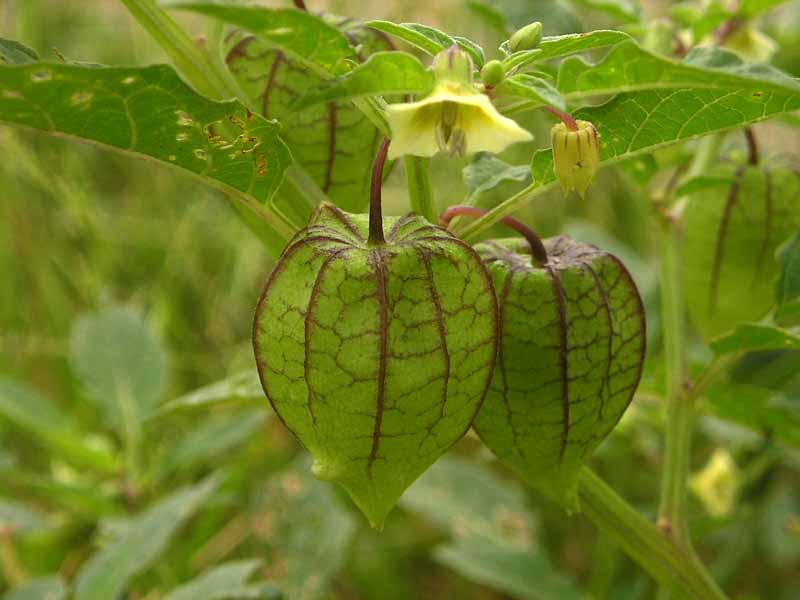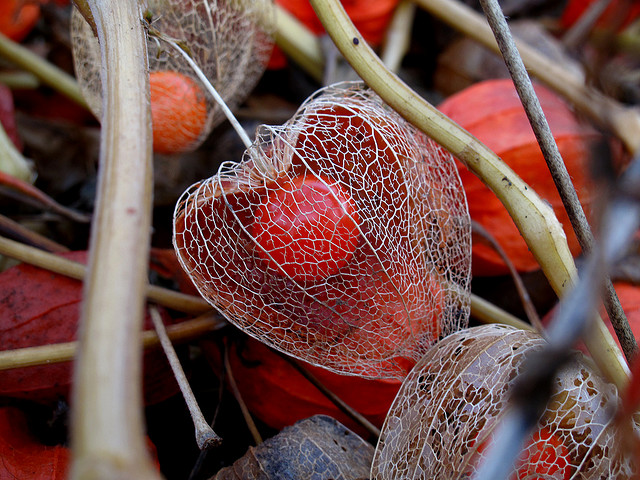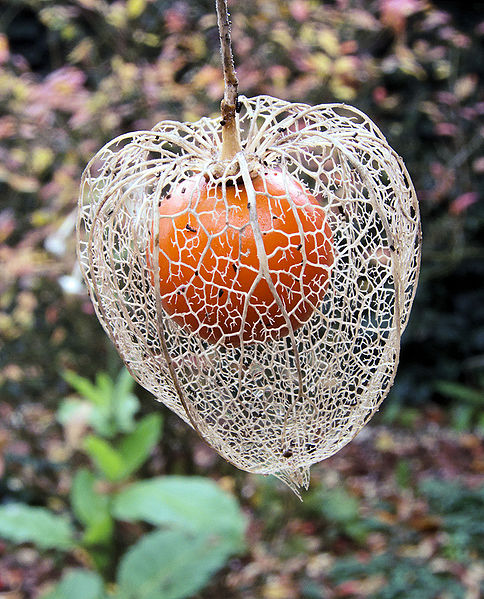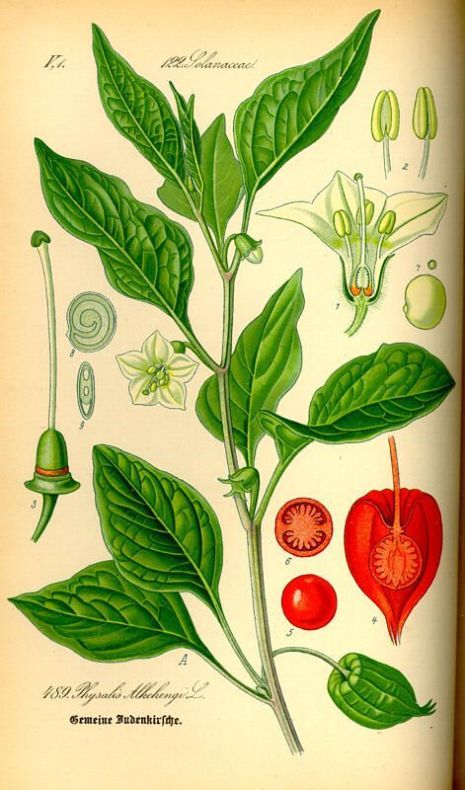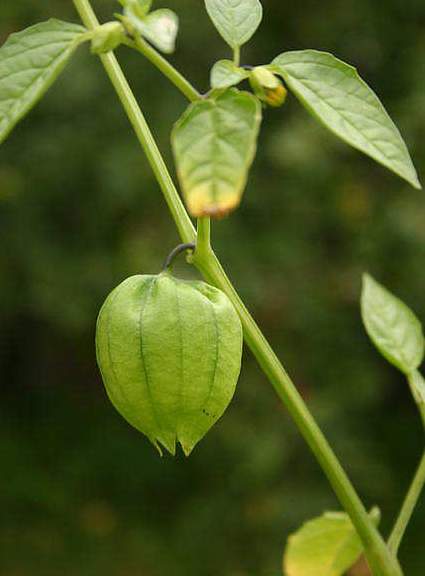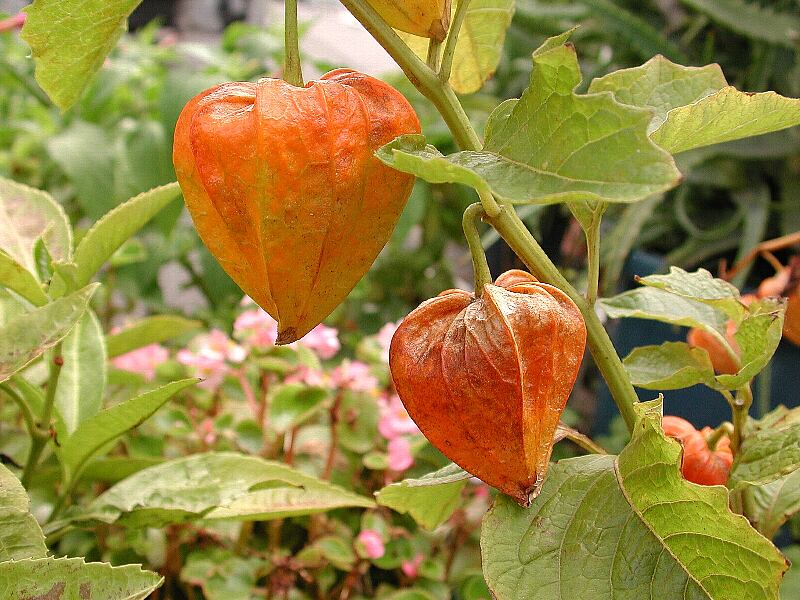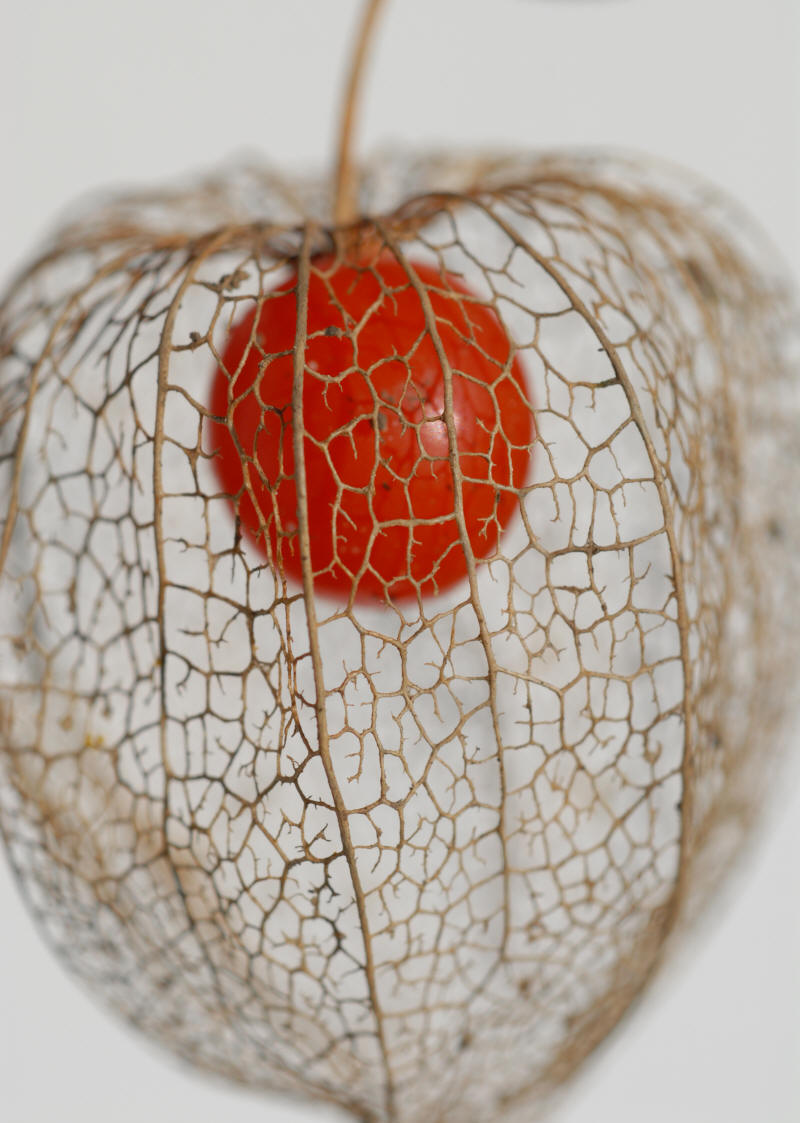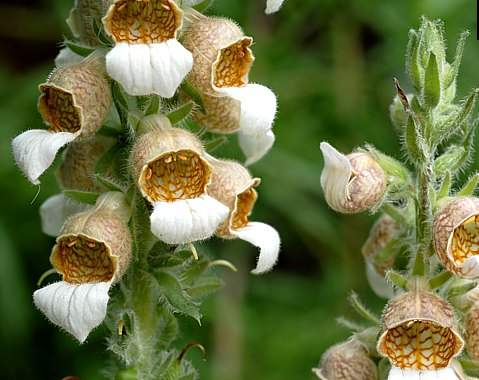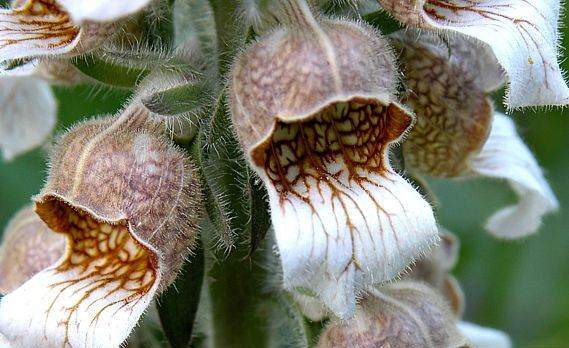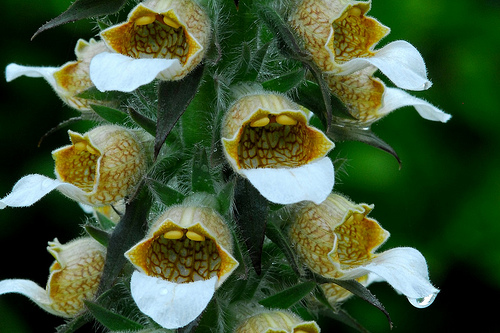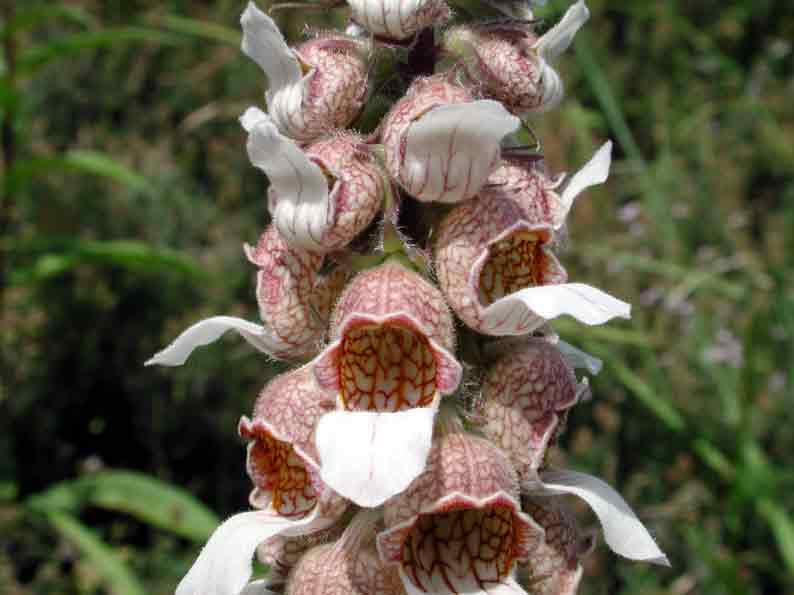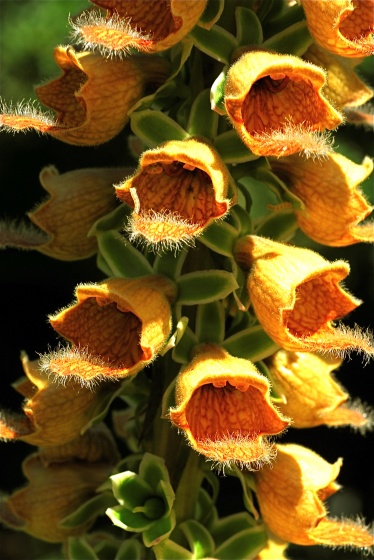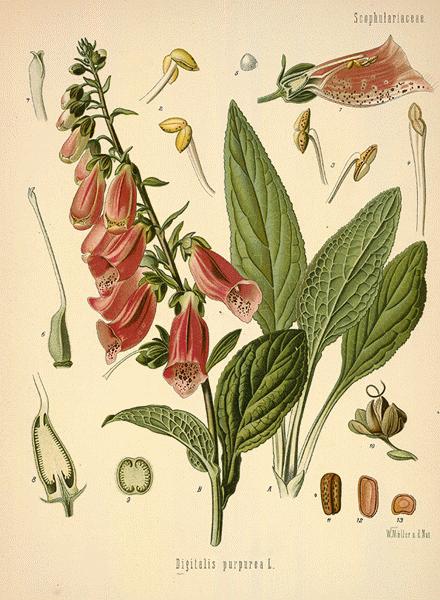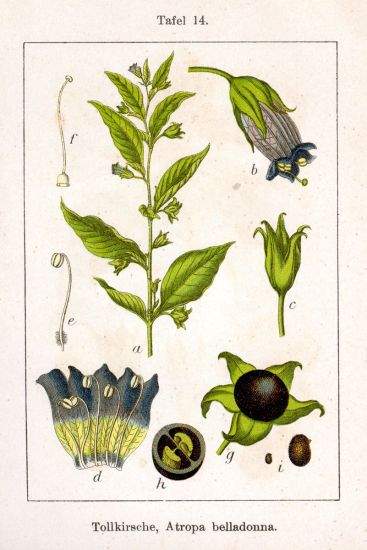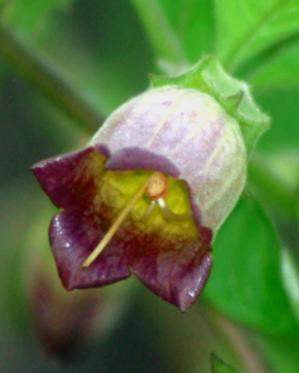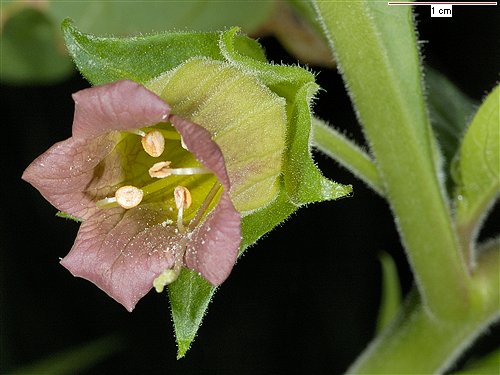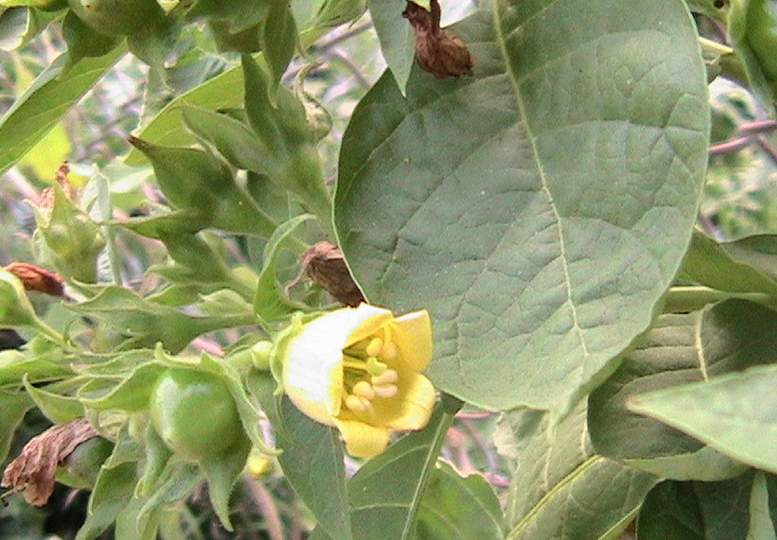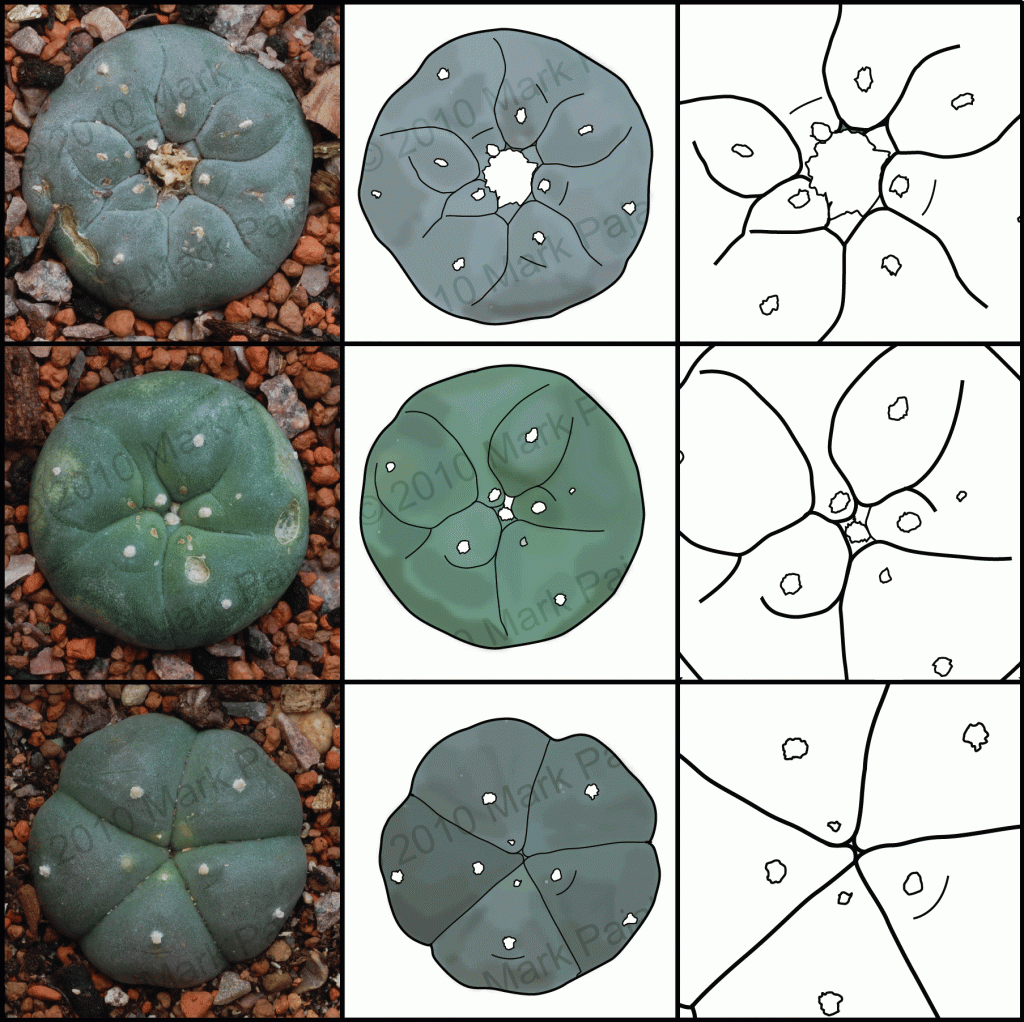
Lophophora williamsii is a small cactus native
to Mexico, Texas and New Mexico.
Growing instructions
Sow seeds in sandy soil. Do not cover the
small seeds, but press gentle into the earth.
Keep seeds in constant moisture with
temperatures of about 20 °C (68 °F). In
winter, the dormant period, plants should be watered very
conditions. Hence the danger of putrescence is high
Therefore sabulous soil or pure sand are beneficial
with sowing of cacti.
For germination cacti need relatively much humidity
and light, a kind of „tropical climate“. They react
very sensitiv to direct sunlight and waterlogging.
A very approved method is sowing Peyote
in a preserving jar. A jar will be filled with a layer
of perlite, seramis, vermiculit or another
drainig material. On top of this comes a layer of sand
on which the seeds will be strewed covered
with a very gauzy layer of translucent
glass sand / arenaceous quartz.
Moisten it enough and cover the jar hermetically
with a polythene foil and leave it at a bright place
protected from direct solar irridation.
Neither air nor humidity can escape and
both should last for the first weeks or even months.
In case mould appears the jar needs to be
ventilated! As soon as the peyote cacti are
about 1 cm high the foil can be carefully taken
away – bit by bit during several days so the plants
can get used to sunlight.
Many friends of cacti bate the sees with
germ repressive agents to avoid putrescence.
Most of the time the seeds are swayed in a powdery agent.
Lophophora Williamsii is a small, grey-green, spineless, napiform cactus possessing remarkable narcotic properties8 rarely exceeding fifteen centimeters in length and five or six in diameter at the top. The chlorophyll-bearing crown is less than one quarter the length of the plant. Peyote plants are normally unicephalous, but age and injury may cause them to become polycephalous, assuming bizarre shapes, often resembling a deerhoof imprint, a circumstance which may account for the close association of peyote with the deer in Mexican Indian mythology.9 The crown is divided into from five to thirteen broad, rounded ribs, separated by straight or spiral furrows. Transverse grooves may divide the ribs into a number of low, polyhedral tubercles, each bearing an areola from which grows a tuft of matted hairs. These tufts of greyish-white, wooly hairs give a lanuginous appearance to the plant which is of importance in etymological considerations.10 The flowers, varying from red to pink or white, are borne on the apical areolae at the top of the crown during June and July. When the crowns of peyote are cut off and dried, they form the so-called mescal buttons which are eaten in the ceremony.
Lophophora Williamsii is not a rare plant. It grows on both banks of the Rio Grande and in scattered places in Aguas Calientes, Chihuahua, Coahuila, Hidalgo, Jalisco, Nuevo Léon, Querétaro, San Luis Potosí, Tamaulipas, and Zacatecas. The Indians of Mexico and the southern plains make annual “pilgrimages” to gather it. Those tribes too distant to visit the peyote-fields procure their supplies by mail from merchants in lower Texas who deal exclusively in mescal buttons.
The narcotic properties of peyote have attracted wide attention. Peyote-intoxication is divisible into two general phases: a period of contentment and over-sensitivity, and a period of nervous calm and muscular sluggishness, often accompanied by hypocerebrality, colored visual hallucinations, and abnormal synæsthesiæ.11 11. Cushny, Pharmacology and Therapeutics; W. E. Dixon, Physiological Action of the Alkaloids; Guttmann, Artificial Psychoses; Hare, Caspari, and Rusby, National Dispensatory; Rouhier, La plante qui fait les yeux émerveillés; Schultes, Peyote (Lophophora Williamsii [Le make] Coulter) and its Uses; Wood, Remington, and Sadtler, Dispensatory.
The pharmacological literature is scattered and voluminous. Since the bibliography of this paper is not intended to be a complete reference list to peyote literature, but merely the most pertinent, only the more important pharmacological sources have been included. 12. Beringer, Meskalinrausch; Guttmann, Artificial Psychoses; Klüver, Mescal. 13. Klüver, Mescal. 14. Beringer, Meskalinrausch; Fernberger, Further Observations. Alterations in tactile sensation, very slight muscular incoordination, disturbances in space and time perception, and auditory hallucinations may accompany severe peyote-intoxication.12 The most striking characteristic, however, is the occasionally induced peyote vision which is often fantastically colored.13
Peyote-intoxication is unique in that during it consciousness is not lost, control of the limbs and senses is maintained, there is no tendency to commit acts of violence, and seldom do uncomfortable effects accompany or follow it. These characteristics are reported in the literature, and I have observed them in the field.
Many investigators agree that peyote is not a habit-forming narcotic. Its use is productive of little social and moral degradation or physical harm, notwithstanding statements to the contrary. The assertions so often made concerning its aphrodisiac properties have been disproved. Furthermore, there is experimental evidence which suggests that it is definitely anaphrodisiacal.14
The narcotic and medicinal properties of peyote are traceable to active principles contained in the tissues of the plant. From four to eight alkaloids may be present in varying amounts and proportions: mescaline, anhalonine, anhalonidine, pellotine, lophophorine, anhalamine, anhalinine, and anhalidine.15 15. Schultes, Peyote (Lophophora Williamsii [Lemaire] Coulter) and its Uses. Several of the alkaloids of Lophophora Williamsii have found minor uses in modern medicine.
In the ceremony, peyote is eaten dry, but occasionally fresh plants are consumed.16 16. Shonle (Peyote) states: “Lumholtz does not emphasize the visions in his accounts of the Tarahumare and Huichol, probably because these tribes obtain the fresh peyote used by the more northern tribes and which has therefore caused the dance to be the central feature of the ceremony rather than the quiet meditation andvisions. But wherever the dried peyote is used, the vision predominates.” in this connection, it must be pointed out that dried peyote is used in Mexico and that I have not been able to discover any difference in physiological action between the fresh and the dried peyote. Since the anhalonium alkaloids are non-volatile, it is not to be expected that desiccation of the plant tissue would have any effect on their concentration. Therefore, the difference in expression of peyote worship in Mexico and the United States cannot be attributed to a physiological effect of the plant, but, it seems to me, must be due to the ceremonial background into which peyote was naturalized in the Plains culture area. 17. Mooney, Mescal Plant Ceremony. 18. Diguet, Les cactacées utiles. 19. V. A. Reko, Magische Gifte-, Rausch- und Genussmittel. 20. Benedict, Visions in Plains Culture. The dried mescal buttons keep indefinitely and are stored in bags for use. They possess a very bitter taste, but in spite of this, they are chewed and swallowed in great number by peyotists. The smallest consumption by a single person is about four buttons at each meeting. It is impossible to estimate the largest, but I have seen an Indian eat more than thirty at one ceremony. Other investigators17 report doses as large as ninety buttons. An estimate of the average consumption, however, would probably be about twelve buttons by each person at a single meeting.
Occasionally, mescal buttons are steeped in water, and the resulting “peyote tea” is drunk. This tea is widely used both in the ceremony and in daily life when peyote is administered medicinally. In Mexico, fresh peyote is ground on a metate, and the resulting thick brown liquid is drunk.18 Mexican Indians sometimes add peyote, thus prepared, to alcoholic fruit juices to produce a delirious intoxication.19 This use of Lophophora Williamsii, however, should not lead to its confusion with mescal, the alcoholic Agave-brandy prepared from Agave spp.
The emphasis on the curing powers of peyote is as great among the northern Indians who use it as it is among the Indians of Mexico. The Kiowa and Comanche, for example, the earliest recipients of peyote on the plains, rely on the cactus as a panacea. Among the Oklahoma tribes with which I worked, I found that there is hardly a disease which is not believed to be curable with peyote. Some of the ills listed as responding to peyote were tuberculosis, pneumonia, scarlet fever, intestinal ills, diabetes, rheumatic pains, colds, grippe, fevers, and venereal diseases. Among the Kiowa, partly masticated mescal buttons are packed around an aching tooth. The Delaware also practice this type of dental therapy.39 39. Petrullo, Diabolic Root. A Shawnee informed me that peyote tea was a good antiseptic wash for open wounds and a soothing liniment if applied warm to an aching limb. It is used “as white man uses aspirin.” Mooney observed: “I have also seen an Indian eat one between meals as a sort of appetizer.”40 40. Mooney, Mescal Plant Ceremony. Several mescal buttons are given three times during childbirth among the Kiowa, Kickapoo, Shawnee, and probably other Plains tribes. The frequent use of peyote as a medicine has led to the statement that the plant is employed as a habit-narcotic, but field investigators deny that this is so
View of base of crown (the central perforation is for stringing for transportation).
An historical survey of the peyote cult in America indicates that, with few exceptions, the first peyote leader of a tribe was converted as the result of a cure and not through a quest for visions. Once converted, he usually tried to impress his friends with the remarkable virtues of the new plant. From a position of indifference or actual hostility, many of the first advocates of the peyote cult became ardent supporters of the religion centering around it. These advocates, likewise, encountered strong opposition from the older and more conservative elements in the tribe. With such powerful forces to fight, peyote leaders would naturally make use of the most influential recommendations that peyote possessed. In the healing power of Lophophora Williamsii, the peyotists found an appeal which completely swept aside conservative opposition and paved the way for rapid acceptance of the plant and its cult. Radin has emphasized this as follows:
In the early days of the peyote cult, it appears that Rave relied principally for new converts upon the knowledge of the great curative virtue of the peyote. The main point, apparently, was to induce people to try it, and I hardly believe that any amount of preaching of its direct effects, such as the hyper-stimulation induced, the glorious visions, and the feeling of relaxation following, would ever have induced prominent members of the medicine bands to do so. For that reason, it is highly significant that all the older members of the peyote speak of the diseases of which it cured them. Along this line lay unquestionably its appeal for the first converts.42 42. Radin, Peyote Cult of the Winnebago.
Of the records of early peyote leaders, only one (John Wilson) indicates that the vision was considered as an appeal, and, in Wilson’s case, the curative properties of peyote were stressed as much, if not more, than the vision. Elk Hair, who simultaneously with John Wilson introduced peyote to the Delaware, consistently refused to eat peyote, although he was critically ill. Finally, however, he submitted to the pleas of friends to have a peyote ceremony for his recovery. The “cure” was successful, and Elk Hair became an ardent peyotist.43 43. Petrullo, Diabolic Root.
Wilson introduced a slightly different type of ceremony to the Delaware. He was not converted through a cure, but became acquainted with peyote through a deliberate effort to learn its virtues. He went into seclusion and spent several weeks in a continuous peyote intoxication, during which time he was “continually translated in spirit to the sky-realm where he was conducted by peyote.”44 44. Speck, Notes on the Life of John Wilson.
The Wilson ceremony is dominant among the Delaware today, and Petrullo feels that the reason for the failure of Elk Hair’s ceremony was due to the fact that “he preached the old religion, and offered only another medico-religious cult,” whereas Wilson “brought to his people a new religion, a hope of building anew, a definite severance with the past.” This may be true to a slight extent, but it is clear that Delaware peyotism, like that of other American Indian tribes, is essentially a medico-religious cult. Petrullo calls attention to this fact himself when he says:
Thus, the peyotist subjects himself to the peyote intoxication, to prayer and concentration on religious matters for twelve and eighteen hours for the sake of helping a fellow man. By concerted effort, by attaining purity, by appealing to peyote, the devotees hope to win the attention of the spirit-forces and their intercession for the sick person. The personal enlightenment and other benefits that may come to one in the course of the meeting are merely incidental in relation to the major objective of effecting a cure.
This statement suggests that the element of curing and health is fundamental to Delaware peyotism.
Wilson himself considered peyote a great medicine, although his own conversion was not through a cure.
[He] approved the use of native herbal remedies, saying that they would do good, but he pointed out that as the peyote worshipper progressed in knowledge, he could ignore the effects of the native pharmacopeia and effect his cures upon himself and others by the sole use of peyote.45 45. Speck, Notes on the Life of John Wilson.
Rave preached about the healing properties of peyote while introducing it among the Winnebago. Like other early peyotists, he had experienced visions, but did not consider them fundamental. Radin emphatically stated:
The first and foremost virtue preached by Rave for the peyote was its curative power. He gives a number of instances in which hopeless venereal diseases and consumption were cured by its use; and this to the present day is the first thing one hears about.46 46. Radin, Peyote Cult of the Winnebago.
This appeal of Lophophora Williamsii as a medicine may be duplicated in almost every tribe regarding whose peyote ceremony sufficient is known. Among the Kickapoo, Kiowa, Shawnee, and Wichita, I heard constant references to the fact that early peyote leaders in the tribes had experienced the curative powers of the plant and had taught of its medicinal virtues.
It is true that the therapeutic appeal is as vital and as influential today as it was fifty years ago. Many of the young peyote devotees whom I interviewed are sincere in their belief in the supremacy of peyote as a medicine. Their faith in the plant extends far beyond its value as a physical medicament, and the enthusiasm with which they described cure after cure indicated clearly that conditions have changed little in this respect from the early days of the cult. Many who stray away from the peyote religion return to its folds in times of sickness and remain faithful when health is restored. La Barre47 47. La Barre, Autobiography of a Kiowa Indian. reports the case of a boy who, having left the peyote cult in his youth, returned to it during sickness twenty years later. This is probably not uncommon and it serves to illustrate once again the importance of the belief in peyote as a guardian and restorer of health.
to Mexico, Texas and New Mexico.
Growing instructions
Sow seeds in sandy soil. Do not cover the
small seeds, but press gentle into the earth.
Keep seeds in constant moisture with
temperatures of about 20 °C (68 °F). In
winter, the dormant period, plants should be watered very
Sowing of peyote and other cacti
Seeds of Peyote and other cacti pullulate on warm humidconditions. Hence the danger of putrescence is high
Therefore sabulous soil or pure sand are beneficial
with sowing of cacti.
For germination cacti need relatively much humidity
and light, a kind of „tropical climate“. They react
very sensitiv to direct sunlight and waterlogging.
A very approved method is sowing Peyote
in a preserving jar. A jar will be filled with a layer
of perlite, seramis, vermiculit or another
drainig material. On top of this comes a layer of sand
on which the seeds will be strewed covered
with a very gauzy layer of translucent
glass sand / arenaceous quartz.
Moisten it enough and cover the jar hermetically
with a polythene foil and leave it at a bright place
protected from direct solar irridation.
Neither air nor humidity can escape and
both should last for the first weeks or even months.
In case mould appears the jar needs to be
ventilated! As soon as the peyote cacti are
about 1 cm high the foil can be carefully taken
away – bit by bit during several days so the plants
can get used to sunlight.
Many friends of cacti bate the sees with
germ repressive agents to avoid putrescence.
Most of the time the seeds are swayed in a powdery agent.
Lophophora Williamsii is a small, grey-green, spineless, napiform cactus possessing remarkable narcotic properties8 rarely exceeding fifteen centimeters in length and five or six in diameter at the top. The chlorophyll-bearing crown is less than one quarter the length of the plant. Peyote plants are normally unicephalous, but age and injury may cause them to become polycephalous, assuming bizarre shapes, often resembling a deerhoof imprint, a circumstance which may account for the close association of peyote with the deer in Mexican Indian mythology.9 The crown is divided into from five to thirteen broad, rounded ribs, separated by straight or spiral furrows. Transverse grooves may divide the ribs into a number of low, polyhedral tubercles, each bearing an areola from which grows a tuft of matted hairs. These tufts of greyish-white, wooly hairs give a lanuginous appearance to the plant which is of importance in etymological considerations.10 The flowers, varying from red to pink or white, are borne on the apical areolae at the top of the crown during June and July. When the crowns of peyote are cut off and dried, they form the so-called mescal buttons which are eaten in the ceremony.
Lophophora Williamsii is not a rare plant. It grows on both banks of the Rio Grande and in scattered places in Aguas Calientes, Chihuahua, Coahuila, Hidalgo, Jalisco, Nuevo Léon, Querétaro, San Luis Potosí, Tamaulipas, and Zacatecas. The Indians of Mexico and the southern plains make annual “pilgrimages” to gather it. Those tribes too distant to visit the peyote-fields procure their supplies by mail from merchants in lower Texas who deal exclusively in mescal buttons.
The narcotic properties of peyote have attracted wide attention. Peyote-intoxication is divisible into two general phases: a period of contentment and over-sensitivity, and a period of nervous calm and muscular sluggishness, often accompanied by hypocerebrality, colored visual hallucinations, and abnormal synæsthesiæ.11 11. Cushny, Pharmacology and Therapeutics; W. E. Dixon, Physiological Action of the Alkaloids; Guttmann, Artificial Psychoses; Hare, Caspari, and Rusby, National Dispensatory; Rouhier, La plante qui fait les yeux émerveillés; Schultes, Peyote (Lophophora Williamsii [Le make] Coulter) and its Uses; Wood, Remington, and Sadtler, Dispensatory.
The pharmacological literature is scattered and voluminous. Since the bibliography of this paper is not intended to be a complete reference list to peyote literature, but merely the most pertinent, only the more important pharmacological sources have been included. 12. Beringer, Meskalinrausch; Guttmann, Artificial Psychoses; Klüver, Mescal. 13. Klüver, Mescal. 14. Beringer, Meskalinrausch; Fernberger, Further Observations. Alterations in tactile sensation, very slight muscular incoordination, disturbances in space and time perception, and auditory hallucinations may accompany severe peyote-intoxication.12 The most striking characteristic, however, is the occasionally induced peyote vision which is often fantastically colored.13
Peyote-intoxication is unique in that during it consciousness is not lost, control of the limbs and senses is maintained, there is no tendency to commit acts of violence, and seldom do uncomfortable effects accompany or follow it. These characteristics are reported in the literature, and I have observed them in the field.
Many investigators agree that peyote is not a habit-forming narcotic. Its use is productive of little social and moral degradation or physical harm, notwithstanding statements to the contrary. The assertions so often made concerning its aphrodisiac properties have been disproved. Furthermore, there is experimental evidence which suggests that it is definitely anaphrodisiacal.14
The narcotic and medicinal properties of peyote are traceable to active principles contained in the tissues of the plant. From four to eight alkaloids may be present in varying amounts and proportions: mescaline, anhalonine, anhalonidine, pellotine, lophophorine, anhalamine, anhalinine, and anhalidine.15 15. Schultes, Peyote (Lophophora Williamsii [Lemaire] Coulter) and its Uses. Several of the alkaloids of Lophophora Williamsii have found minor uses in modern medicine.
In the ceremony, peyote is eaten dry, but occasionally fresh plants are consumed.16 16. Shonle (Peyote) states: “Lumholtz does not emphasize the visions in his accounts of the Tarahumare and Huichol, probably because these tribes obtain the fresh peyote used by the more northern tribes and which has therefore caused the dance to be the central feature of the ceremony rather than the quiet meditation andvisions. But wherever the dried peyote is used, the vision predominates.” in this connection, it must be pointed out that dried peyote is used in Mexico and that I have not been able to discover any difference in physiological action between the fresh and the dried peyote. Since the anhalonium alkaloids are non-volatile, it is not to be expected that desiccation of the plant tissue would have any effect on their concentration. Therefore, the difference in expression of peyote worship in Mexico and the United States cannot be attributed to a physiological effect of the plant, but, it seems to me, must be due to the ceremonial background into which peyote was naturalized in the Plains culture area. 17. Mooney, Mescal Plant Ceremony. 18. Diguet, Les cactacées utiles. 19. V. A. Reko, Magische Gifte-, Rausch- und Genussmittel. 20. Benedict, Visions in Plains Culture. The dried mescal buttons keep indefinitely and are stored in bags for use. They possess a very bitter taste, but in spite of this, they are chewed and swallowed in great number by peyotists. The smallest consumption by a single person is about four buttons at each meeting. It is impossible to estimate the largest, but I have seen an Indian eat more than thirty at one ceremony. Other investigators17 report doses as large as ninety buttons. An estimate of the average consumption, however, would probably be about twelve buttons by each person at a single meeting.
Occasionally, mescal buttons are steeped in water, and the resulting “peyote tea” is drunk. This tea is widely used both in the ceremony and in daily life when peyote is administered medicinally. In Mexico, fresh peyote is ground on a metate, and the resulting thick brown liquid is drunk.18 Mexican Indians sometimes add peyote, thus prepared, to alcoholic fruit juices to produce a delirious intoxication.19 This use of Lophophora Williamsii, however, should not lead to its confusion with mescal, the alcoholic Agave-brandy prepared from Agave spp.
The emphasis on the curing powers of peyote is as great among the northern Indians who use it as it is among the Indians of Mexico. The Kiowa and Comanche, for example, the earliest recipients of peyote on the plains, rely on the cactus as a panacea. Among the Oklahoma tribes with which I worked, I found that there is hardly a disease which is not believed to be curable with peyote. Some of the ills listed as responding to peyote were tuberculosis, pneumonia, scarlet fever, intestinal ills, diabetes, rheumatic pains, colds, grippe, fevers, and venereal diseases. Among the Kiowa, partly masticated mescal buttons are packed around an aching tooth. The Delaware also practice this type of dental therapy.39 39. Petrullo, Diabolic Root. A Shawnee informed me that peyote tea was a good antiseptic wash for open wounds and a soothing liniment if applied warm to an aching limb. It is used “as white man uses aspirin.” Mooney observed: “I have also seen an Indian eat one between meals as a sort of appetizer.”40 40. Mooney, Mescal Plant Ceremony. Several mescal buttons are given three times during childbirth among the Kiowa, Kickapoo, Shawnee, and probably other Plains tribes. The frequent use of peyote as a medicine has led to the statement that the plant is employed as a habit-narcotic, but field investigators deny that this is so
View of base of crown (the central perforation is for stringing for transportation).
An historical survey of the peyote cult in America indicates that, with few exceptions, the first peyote leader of a tribe was converted as the result of a cure and not through a quest for visions. Once converted, he usually tried to impress his friends with the remarkable virtues of the new plant. From a position of indifference or actual hostility, many of the first advocates of the peyote cult became ardent supporters of the religion centering around it. These advocates, likewise, encountered strong opposition from the older and more conservative elements in the tribe. With such powerful forces to fight, peyote leaders would naturally make use of the most influential recommendations that peyote possessed. In the healing power of Lophophora Williamsii, the peyotists found an appeal which completely swept aside conservative opposition and paved the way for rapid acceptance of the plant and its cult. Radin has emphasized this as follows:
In the early days of the peyote cult, it appears that Rave relied principally for new converts upon the knowledge of the great curative virtue of the peyote. The main point, apparently, was to induce people to try it, and I hardly believe that any amount of preaching of its direct effects, such as the hyper-stimulation induced, the glorious visions, and the feeling of relaxation following, would ever have induced prominent members of the medicine bands to do so. For that reason, it is highly significant that all the older members of the peyote speak of the diseases of which it cured them. Along this line lay unquestionably its appeal for the first converts.42 42. Radin, Peyote Cult of the Winnebago.
Of the records of early peyote leaders, only one (John Wilson) indicates that the vision was considered as an appeal, and, in Wilson’s case, the curative properties of peyote were stressed as much, if not more, than the vision. Elk Hair, who simultaneously with John Wilson introduced peyote to the Delaware, consistently refused to eat peyote, although he was critically ill. Finally, however, he submitted to the pleas of friends to have a peyote ceremony for his recovery. The “cure” was successful, and Elk Hair became an ardent peyotist.43 43. Petrullo, Diabolic Root.
Wilson introduced a slightly different type of ceremony to the Delaware. He was not converted through a cure, but became acquainted with peyote through a deliberate effort to learn its virtues. He went into seclusion and spent several weeks in a continuous peyote intoxication, during which time he was “continually translated in spirit to the sky-realm where he was conducted by peyote.”44 44. Speck, Notes on the Life of John Wilson.
The Wilson ceremony is dominant among the Delaware today, and Petrullo feels that the reason for the failure of Elk Hair’s ceremony was due to the fact that “he preached the old religion, and offered only another medico-religious cult,” whereas Wilson “brought to his people a new religion, a hope of building anew, a definite severance with the past.” This may be true to a slight extent, but it is clear that Delaware peyotism, like that of other American Indian tribes, is essentially a medico-religious cult. Petrullo calls attention to this fact himself when he says:
Thus, the peyotist subjects himself to the peyote intoxication, to prayer and concentration on religious matters for twelve and eighteen hours for the sake of helping a fellow man. By concerted effort, by attaining purity, by appealing to peyote, the devotees hope to win the attention of the spirit-forces and their intercession for the sick person. The personal enlightenment and other benefits that may come to one in the course of the meeting are merely incidental in relation to the major objective of effecting a cure.
This statement suggests that the element of curing and health is fundamental to Delaware peyotism.
Wilson himself considered peyote a great medicine, although his own conversion was not through a cure.
[He] approved the use of native herbal remedies, saying that they would do good, but he pointed out that as the peyote worshipper progressed in knowledge, he could ignore the effects of the native pharmacopeia and effect his cures upon himself and others by the sole use of peyote.45 45. Speck, Notes on the Life of John Wilson.
Rave preached about the healing properties of peyote while introducing it among the Winnebago. Like other early peyotists, he had experienced visions, but did not consider them fundamental. Radin emphatically stated:
The first and foremost virtue preached by Rave for the peyote was its curative power. He gives a number of instances in which hopeless venereal diseases and consumption were cured by its use; and this to the present day is the first thing one hears about.46 46. Radin, Peyote Cult of the Winnebago.
This appeal of Lophophora Williamsii as a medicine may be duplicated in almost every tribe regarding whose peyote ceremony sufficient is known. Among the Kickapoo, Kiowa, Shawnee, and Wichita, I heard constant references to the fact that early peyote leaders in the tribes had experienced the curative powers of the plant and had taught of its medicinal virtues.
It is true that the therapeutic appeal is as vital and as influential today as it was fifty years ago. Many of the young peyote devotees whom I interviewed are sincere in their belief in the supremacy of peyote as a medicine. Their faith in the plant extends far beyond its value as a physical medicament, and the enthusiasm with which they described cure after cure indicated clearly that conditions have changed little in this respect from the early days of the cult. Many who stray away from the peyote religion return to its folds in times of sickness and remain faithful when health is restored. La Barre47 47. La Barre, Autobiography of a Kiowa Indian. reports the case of a boy who, having left the peyote cult in his youth, returned to it during sickness twenty years later. This is probably not uncommon and it serves to illustrate once again the importance of the belief in peyote as a guardian and restorer of health.
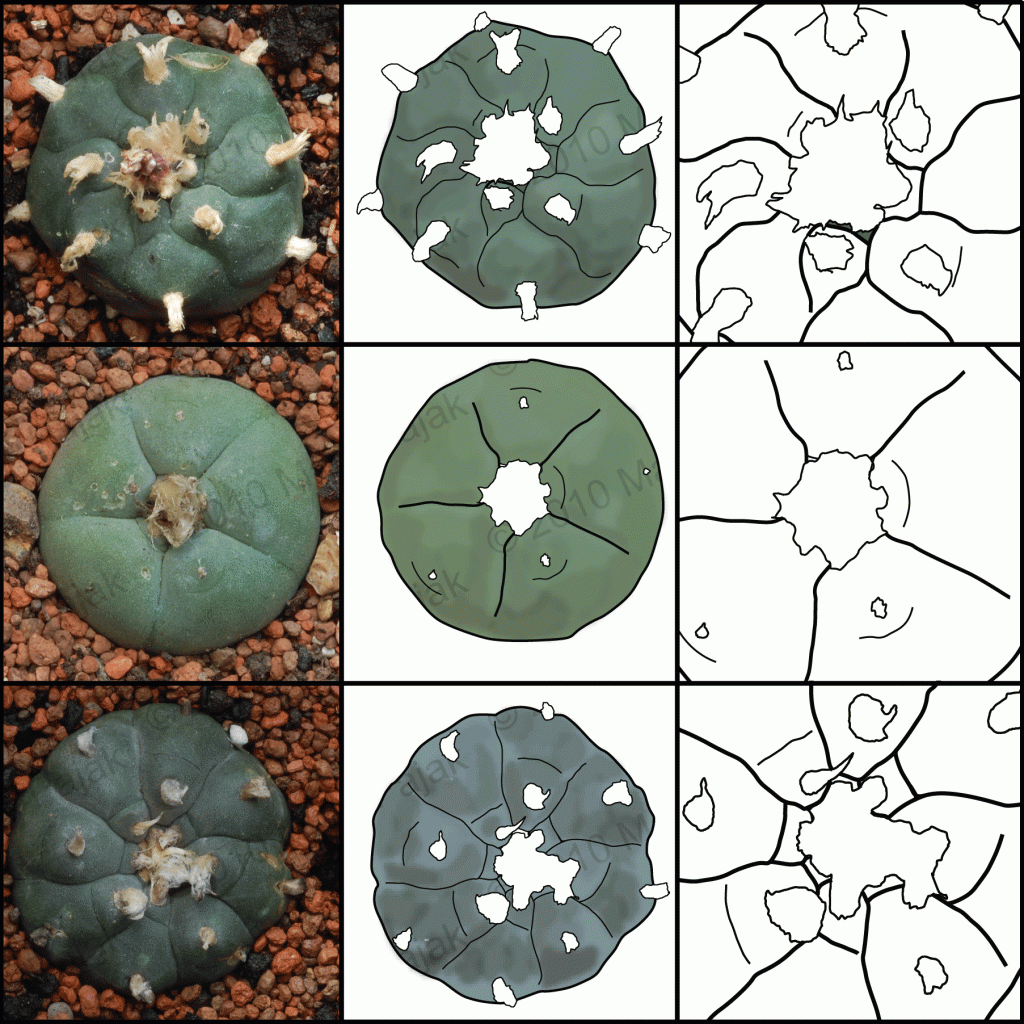
Description: Globular spineless cactus with large tap root.
Stem: Pale grey-green to yellow-green, usually lacking well defined ribs and furrows.
Ribs: 5 to 13 the podaria are rarely elevated, but are broad and flat.
Areoles: With tufts of hairs that usually spread unequally on the prominent podaria.
Flowers: Commonly pale to dark pink ( or rarely pinkish white), reaching over 4 centimeter in diameter.
In habitat Lophophora fricii is a very mutable species. It´s hardly to find two similar plants at one location. Particularly in terms of the bloom they are different at the same locations.
Propagation: Seeds. Seeds should be sown in spring in sterile cacti mix. Cover with a humidity dome or plastic wrap and leave in a warm spot in 50-75% shade. Fluctuating temperatures are best (ie. high day temperature and low night temperature) as they simulate the desert environment. Keep constantly humid as seedlings cannot survive if to dry. Seedlings will emerge in 7-21 days and can be grown in the same environment for a number of months. Mulch with thin layer of small quartz gravel (1-2mm diameter) this helps them stay upright, hinders algae growth and regulates moisture. As they get older the watering can become less frequent. Potting up can be done when 5-10mm in diameter.
Cultivation: Slow growing. Because of the tap root they are very rot prone, so use highly gritty compost with much drainage. Requires half shade to part sun. Watering: watering should be rather infrequent to keep the plant compact and avoid it becoming excessively elongated and unnatural in appearance. Watering it properly is often difficult, because this plant tends to crack open or rot if over-watered. The fact that the plant retracts into the soil and assumes a grey-green colouring between watering, is perfectly natural, and doesn’t cause any damage.
Overwatering: Keep completely dry and cool in winter (An unheated greenhouse would be perfect) or when night temperatures remain below 10° C, it can survive low temperatures (appr. -7°C) for a short period. Assure a good ventilation.
Stem: Pale grey-green to yellow-green, usually lacking well defined ribs and furrows.
Ribs: 5 to 13 the podaria are rarely elevated, but are broad and flat.
Areoles: With tufts of hairs that usually spread unequally on the prominent podaria.
Flowers: Commonly pale to dark pink ( or rarely pinkish white), reaching over 4 centimeter in diameter.
In habitat Lophophora fricii is a very mutable species. It´s hardly to find two similar plants at one location. Particularly in terms of the bloom they are different at the same locations.
Propagation: Seeds. Seeds should be sown in spring in sterile cacti mix. Cover with a humidity dome or plastic wrap and leave in a warm spot in 50-75% shade. Fluctuating temperatures are best (ie. high day temperature and low night temperature) as they simulate the desert environment. Keep constantly humid as seedlings cannot survive if to dry. Seedlings will emerge in 7-21 days and can be grown in the same environment for a number of months. Mulch with thin layer of small quartz gravel (1-2mm diameter) this helps them stay upright, hinders algae growth and regulates moisture. As they get older the watering can become less frequent. Potting up can be done when 5-10mm in diameter.
Cultivation: Slow growing. Because of the tap root they are very rot prone, so use highly gritty compost with much drainage. Requires half shade to part sun. Watering: watering should be rather infrequent to keep the plant compact and avoid it becoming excessively elongated and unnatural in appearance. Watering it properly is often difficult, because this plant tends to crack open or rot if over-watered. The fact that the plant retracts into the soil and assumes a grey-green colouring between watering, is perfectly natural, and doesn’t cause any damage.
Overwatering: Keep completely dry and cool in winter (An unheated greenhouse would be perfect) or when night temperatures remain below 10° C, it can survive low temperatures (appr. -7°C) for a short period. Assure a good ventilation.
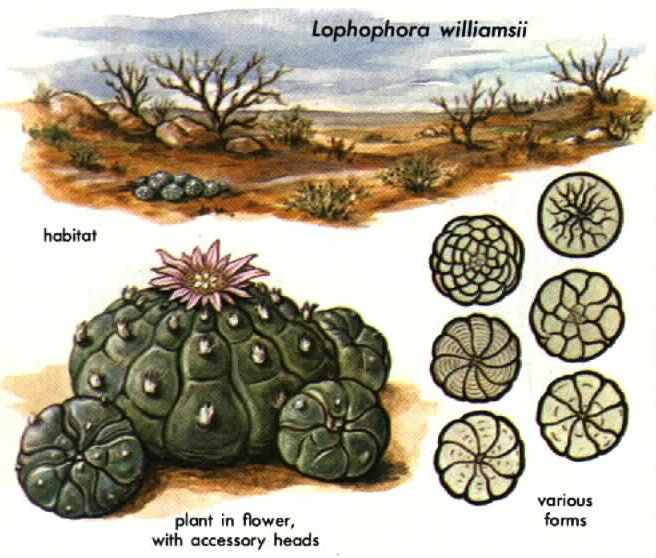
PEYOTE (lophophora williamsii), an unobtrusive cactus that grows in rocky deserts, is the most spectacular hallucinogenic plant of the New World. It is also one of the earliest known. The Aztecs used it, calling it peyotl.
Peyote is a small, fleshy, spineless cactus with a rounded gray-green top, tufts of white hair, and a long carrotlike root. It rarely exceeds 7-1/2 inches in length or 3 inches across. The Indians cut off the crowns to sun-dry into brown, discoidal "mescal buttons" that last long periods and can be shipped to distant points for use. When the top is severed, the plant often sprouts new crowns so that many-headed peyotes are common
To graft Peyote, choose a fast growing collumnular cacti as the grafting stock. Most collumnular cacti will be fine, but Trichocereus pachanoi and Myrtillocactus geometrizans are both excellent choices because they are fast growing, water tolerant, and reasonably spineless. Unless you have no choice, do not use stock plants grown from seed. They often taper at the base, and may topple once used for grafting, rooted cuttings from these plants will be far more stable.
Perform a flat graft on Peyote. Under optimum conditions, the graft will heal within days and new growth may be seen within weeks (although this may take considerably longer). As with other slow growing cacti, grafted Peyote may become bloated or mishaped due to increased growth rate. Once your grafted Peyote has reached flowering size and possibly has side pups, you may wish to remove the Peyote scion from the stock and reroot it on it's own roots for a beautifully productive parent plant.
Soil Mixtures
Peyote will do well in any free draining compost mix. Although to promote flowering it is recommended to add Gypsum or Dolomite. Calcium is also thought to benefit Peyote. A good mix would be:
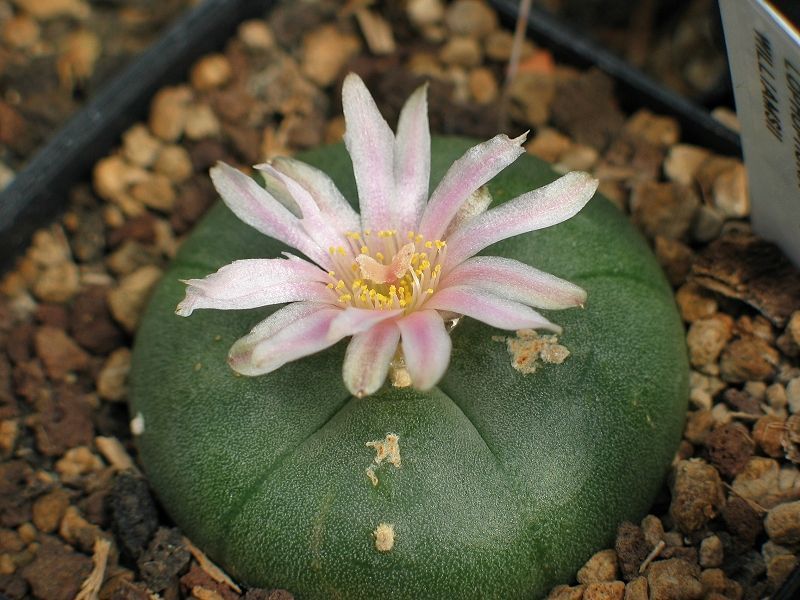
USE OF PEYOTE BY THE AZTECS was described by Spanish chroniclers. One reported that those who ate it saw frightful visions and remained drunk for two or three days; that it was a common food of the Chichimeca Indians, "sustaining them and giving them courage to fight and not feel fear nor hunger nor thirst; and they say that it protects them from all danger." In 1591, another chronicler wrote that the natives who eat it "lose their senses, see visions of terrifying sights like the devil, and are able to prophesy their future with 'satanic trickery.' "
Dr. Hernández, the physician to the King of Spain, described the cactus as Peyotl zacatecensis and wrote of its "wonderful properties." He took note of its small size and described it by saying that "it scarcely issues from the earth, as if it did not wish to harm those who find and eat it." Recent archaeological finds of peyote buttons in the state of Texas are approximately 1 ,000 years old. OPPOSITION TO THE USE OF PEYOTE by the Aztecs was strong among the Spanish conquerors. One early Spanish church document likened the eating of peyote to cannibalism. Upset by the religious hold that peyote had on the Indians, the Spanish tried, with great vigor but little success, to stamp out its use.
By 1720, the eating of peyote was prohibited throughout Mexico. But despite four centuries of civil and ecclesiastical persecution, the use and importance of peyote have spread beyond its early limited confines. Today it is so strongly anchored in native lore that even Christianized Indians believe that a patron saint—El Santo Niño de Peyotl—walks on the hills where peyote grows.
There is continuing opposition in certain religious organizations in the United States to the Indians' use of peyote as a ceremonial sacrament. Nevertheless, the federal government has never seriously questioned or interfered with the practice since it is essentially a religious one. Those tribes living far from sources of peyote—some as far north as Canada—can legally import mescal buttons by mail. Despite constitutional guarantees separating church and state, however, a few states have enforced repressive laws against even the religious use of peyote
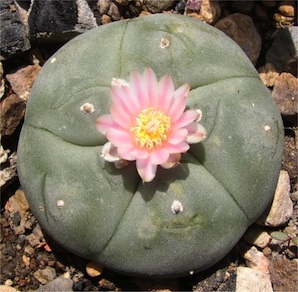
RELIGIOUS IMPORTANCE OF PEYOTE persists among the Tarohumare, Huichol, and other Mexican Indians. The Tarahumare believe that when Father Sun left earth to dwell above, he left peyote, or hikuli, to cure man's ills and woes; thot peyote sings and talks as it grows; that when gathered it sings happily in its bags all the way home; and that God speaks through the plant in this way.
Many legends about the supernatural powers of peyote underlie its religious importance. It might be esteemed merely as an everyday medicine, but it hos been exalted to a position of near-divinity. The peyote-collecting trip of the Huichols, for example, is highly religious, requiring pilgrims to forego adult experiences, especially sexual, for it reenacts the first peyote quest of the divine ancestors. The pilgrims must confess in order to become spirit and enter into the sacred country through the gateway of clashing clouds, a journey which, according to their tradition, repeats the "journey of the soul of the dead to the underworld
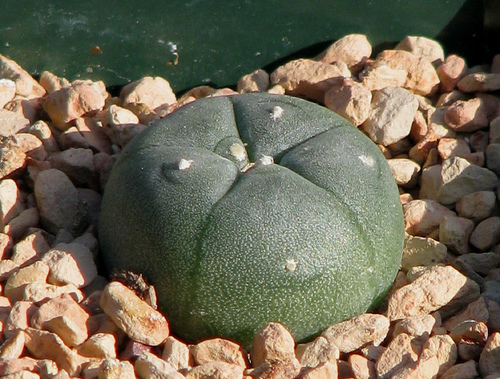
Luxuriant visual- and auditory hallucinations, alteration in space- and time perception, sensations of weightlessness, macropsia, depersonalisation. Mescaline has stimulating effects in lower- and sedative effects in higher doses.
Autonomic changes: nausea, pupillary dilation, increased pulse rate and blood pressure, elevated body temperature, profuse sweating, tremor and the threshold for elicitation of the knee jerk is decreased.
Duration:
The effects appear within two hours after ingestion and last for four to twelve hours.
Dosage and preparation:
The chlorophyllous part of the cactus (buttons) should be cut from the root and can be chewed fresh, or in their dried state, but it can also be prepared as a tea.
4-30 buttons produce psychedelic effects. Fresh peyote contains 0.4 % mescaline per weight, dried buttons 2.74-3.7%. Mescaline itself is fysiologically active between 200-500mg.
Botanical aspects:
L. Williamsii belongs to Cactaceae; Cactoideae, Tribus Cerereae, subtribus Echinocacteninae. It is indigenous to central Mexico and teritory noth to southern Texas and New Mexico. Peyote is a small gray-green desert cactus, which has tufts of cotton like material instead of thorns. Its white/pink flowers appear from the centre of the top and after pollination pink seed capsules appear. Reproduction follows through seeds. Seed germination requires a humid, warm environment (18-25 °C) and may last up to several weeks
Peyote was first described botanically in 1845 and called Echinocactus williamsii. It has been given many other technical names. The one used most commonly by chemists has been Anhalonium lewinii. Most botanists now agree peyote belongs in a distinct genus, Lophophora. There are two species: the widespread L. williamsii and the local L. diffusa in Querétaro.
Peyote is native to the Rio Grande valley of Texas and northern and central parts of the Mexican plateau. It belongs to the cactus family, Cactaceae, comprising some 2,000 species in 50 to 150 genera, native primarily to the drier parts of tropical America. Many species are valued as horticultural curiosities, and some have interesting folk uses among the Indians
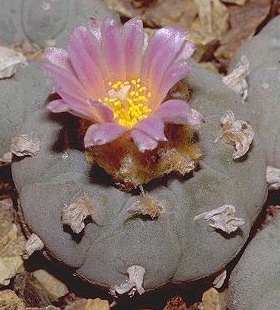
EFFECTS OF PEYOTE on the mind and body are so utterly unworldly and fantastic that it is easy to understand the native belief that the cactus must be the residence of spirit forces or a divinity. The most spectacular of the many effects is the kaleidoscopic play of indescribably rich, colored visions. Hallucinations of hearing, feeling, and taste often occur as well.
The intoxication may be divided into two periods: one of contentment and extrasensitivity, followed by artificial calm and muscular sluggishness at which time the subject begins to pay less attention to his surroundings and increase his introspective "meditation.' Before visions appear, some three hours after eating peyote, there are flashes and scintillations in colors, their depth and saturation defying description. The visions often follow a sequence from geometric figures to unfamiliar and grotesque objects that vary with the individual.
Though the colored visual hallucinations undoubtedly underlie the rapid spread of the use of peyote, especially in those Indian cultures where the quest for visions has always been important, many natives assert that visions are "not good" and lack religious significance. Peyote's reputation as a panacea and all-powerful "medicine" - both in physical and psychic sense - may be equally responsible for its spread.
USE OF PEYOTE IN THE UNITED STATES first came to public attention about 1880 when the Kiowa and the Comanche Indians established a peyote ceremony derived from the Mexican but remodeled into a visionquest ritual typical of the Plains Indians. Use of peyote had been recorded earlier, in 1720, in Texas. How the use of peyote diffused from Mexico north, far beyond the natural range of the cactus, is not fully known. During the 1880's, many Indian missionaries were active in spreading the peyote ceremony from tribe to tribe. By 1920, the peyote cult numbered over 13,000 faithful in more than 30 tribes in North America. It was legally organized, partly for protection against fierce Christian - missionary persecution, into the Native American Church, which now claims 250,000 members. This cult, a combination of Christian and native elements, teaches brotherly love, high moral principles, and abstention from alcohol. It considers peyote a sacrament through which God manifests Himself to man.THE PEYOTE RITUAL as practiced by Indians in the United States varies somewhat from tribe to tribe. A typical Plains Indian ceremony takes place weekly in an all-night meeting in a teepee. Worshipers sit in a circle around a half-moon altar of sand (see p. 6) on which a large specimen called a "Father Peyote" is set and at which a sacred fire burns. The ashes are shaped into the form of a thunderbird. The ceremony, led by a "roadman,'' consists of chanting accompanied by rattle and drum, alternating with prayers, lessons, testimonies, and occasionally a curing ritual. At night dried peyote tops (mescal buttons) are moistened and swallowed—from 4 to 30 or more. The ritual ends with breakfast at down when the teepee is hauled down
A PEYOTE VISION was described by a scientist who experienced it as follows: " . . . clouds . . . Oil of pheasant turns into bright yellow star; star into sparks. Moving, scintillating screw; hundreds of screws. A sequence of rapidly changing objects in agreeable colors. A rotating wheel in the center of a silvery ground . . . The upper part of a man with a pale face and red cheeks, rising slowly from below. While I am thinking of a friend, the head of an Indian appears. Beads in different colors . . . so bright that I doubt my eyes are closed.... Yellow moss like saltwater taffy pierced by two teeth. Silvery water pouring downward, suddenly flowing upward . . . exploding shells turn into strange flowers . . . A drawing of a head turns into a mushroom, then a skeleton in lateral view . . . Head and legs are lacking . . . Soft, deep darkness with moving wheels and stars in . . . pleasant colors. Nuns in silver dress . .. quickly disappearing. Collection of bluish ink bottles with labels. Red, brownish, and violet threads running together in the center. Autumn leaves turning into mescal buttons . . . Man in greenish velvet jumping into a deep chasm. Strange animal turns into a piece of wood in horizontal position."
